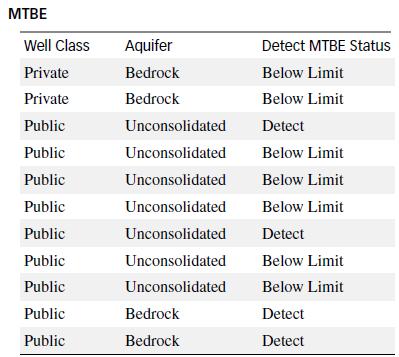Refer to the Environmental Science & Technology (Jan. 2005) study of methyl tert-butyl ether (MTBE) contamination in
Question:
Refer to the Environmental Science & Technology (Jan. 2005) study of methyl tert-butyl ether (MTBE) contamination in public and private New Hampshire wells, Exercise 2.12. Recall that data on well class (public or private), aquifer (bedrock or unconsolidated), and detectable level of MTBE (below limit or detect) were collected for a sample of 223 wells. These data are saved in the MTBE file.

a. Use the data in the MTBE file to create a contingency table for well class and detectable MTBE status.
b. Conduct a test to determine if detectable MTBE status depends on well class. Test using α = .05.
c. Use the data in the MTBE file to create a contingency table for aquifer and detectable MTBE status.
d. Conduct a test to determine if detectable MTBE status depends on aquifer. Test using α = .05.
Data from Exercise 2.12
In New Hampshire, about half the counties mandate the use of reformulated gasoline. This has led to an increase in the contamination of groundwater with methyl tert-butyl ether (MTBE). Environmental Science & Technology (Jan. 2005) reported on the factors related to MTBE contamination in public and private New Hampshire wells. Data were collected for a sample of 223 wells. These data are saved in the MTBE file. Three of the variables are qualitative in nature: well class (public or private), aquifer (bedrock or unconsolidated), and detectable level of MTBE (below limit or detect). The data for 10 selected wells are shown in the accompanying table. Use graphical methods to describe each of the three qualitative variables for all 223 wells.
Step by Step Answer:

Statistics For Engineering And The Sciences
ISBN: 9781498728850
6th Edition
Authors: William M. Mendenhall, Terry L. Sincich





